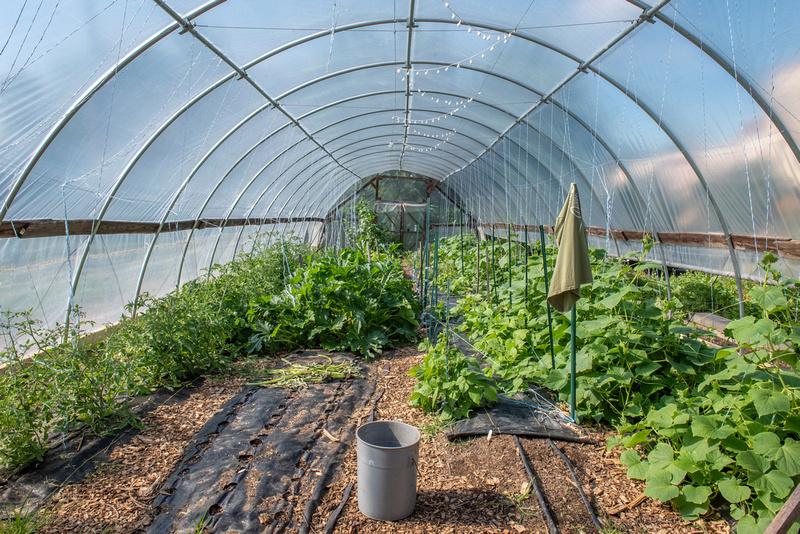High tunnels (or hoop houses) extend the growing season for specialty crops. This article will help growers learn how to get the most out of their high tunnel by adopting best management practices for temperature management, soil and growing media monitoring, safety considerations, pest management, and crop selection.
For a printer-friendly version of this article, click here.
Temperature management
- You will need to prevent extremes of both cold and heat
- To prevent temperature extremes, you need to know what the temperature is! Low tech and high tech tools are available to help with this.
- Passive warming methods include floating row cover, low tunnels, double layer of plastic with air blown in between.
- Active warming methods include propane, gas, and electric heaters. But be careful of fire hazards and ensure proper ventilation!
- Cooling methods include shade cloth, vents (roll up or roof), and white wash
- Learn more: https://go.umd.edu/tunneltemp
Soil and growing media management
- In addition to fertility, it is particularly important in a high tunnel to monitor salinity and pH. Learn more: https://go.umd.edu/fs1128
Safety considerations
- The risk of heat illness is increased by humidity and lack of airflow, exactly what you’ll find in a high tunnel! The risk is elevated for elders, infants, and people with circulatory or heart conditions. Be especially careful when wearing Personal Protective Equipment.
- Air quality: reduced air flow in high tunnels can create pools of pollutants from outdoor air, including ozone. Ozone can damage plants as well as human lungs. Avoid working in a high tunnel during “code orange” air quality alerts.
- Pesticide safety: A high tunnel is a semi-enclosed environment with restricted airflow. When using any pesticide, even organic pesticides, read and follow the label. It may be necessary to ventilate or wear additional safety equipment when using a pesticide in a high tunnel.
Pest management
- Controlling moisture and humidity can reduce disease pressure. Avoid over-head watering. Instead, use drip irrigation where possible.
- Common pests in high tunnels include thrips, aphids, and mites. Common diseases in high tunnels include powdery mildew on cucurbits.
For more on mites and thrips in high tunnels, see articles by Jerry Brust: https://go.umd.edu/tunnelthrips - Using insect netting or screens over high tunnel vents can help exclude pests.
Crop selection
- Your high tunnel is your farm’s prime real estate. Choose what to grow in your high tunnel wisely.
- Choose crops that will take advantage of the high tunnel’s benefits: For example, growing tomatoes or cut flowers in a high tunnel can protect them from extreme rain events and moisture-loving diseases.
- Choose crops that will provide market differentiation. For example, planting tomatoes early in a high tunnel can enable you to be one of the first growers at the farmers’ market with tomatoes in the spring. Growing ginger or turmeric in a high tunnel can enable you to grow these heat-loving crops further north than their native range.
- UDel high tunnel planting schedule: https://sites.udel.edu/weeklycropupdate/?p=6620
- Choose varieties that are adapted to high tunnel growing conditions and resistant to common diseases:
- Tomato varieties for high tunnels: https://go.umd.edu/tunneltomatoes
- Disease resistant tomato varieties: https://go.umd.edu/cornelltomatoes
- Cucumber high tunnel production guide: https://go.umd.edu/tunnelcucumbers
- Disease resistant cucurbit varieties: https://go.umd.edu/cornellcucurbits
Additional resources
- High Tunnel Best Management Practices webinar: https://www.youtube.com/watch?v=BWQdfnmJNNE
- MD NRCS: https://www.nrcs.usda.gov/wps/portal/nrcs/site/md/home/
- MD Urban Ag website: https://go.umd.edu/urbanag
- Urban Ag E-News: https://go.umd.edu/subscribeurbanag
- Penn State High Tunnel Manual:
https://extension.psu.edu/high-tunnel-manual - “High tunnels in urban agriculture” by ATTRA: https://go.umd.edu/urbantunnel
- “Season Extension Techniques for Market Gardeners” by ATTRA: https://go.umd.edu/markettunnel
This work funded by a grant from USDA-NRCS MD, Award # NR203B19XXXXC003
University programs, activities, and facilities are available to all without regard to race, color, sex, gender identity or expression, sexual orientation, marital status, age, national origin, political affiliation, physical or mental disability, religion, protected veteran status, genetic information, personal appearance, or any other legally protected class. If you need a reasonable accommodation to participate in any event or activity, please contact your local University of Maryland Extension Office.
Los programas, actividades e instalaciones de la universidad están disponibles para todos sin distinción de raza, color, sexo, identidad o expresión de género, orientación sexual, estado civil, edad, origen nacional, afiliación política, discapacidad física o mental, religión, estado de veterano protegido, información genética, apariencia personal o cualquier otra clase legalmente protegida. Si necesita adaptaciones razonables para participar en cualquier evento o actividad, comuníquese con la Oficina de Extensión de la Universidad de Maryland de su localidad.
